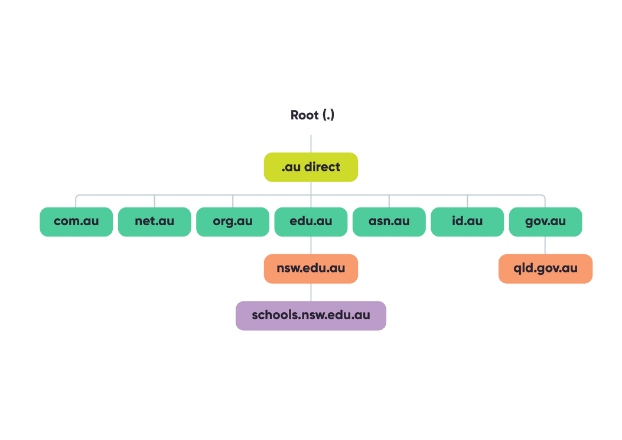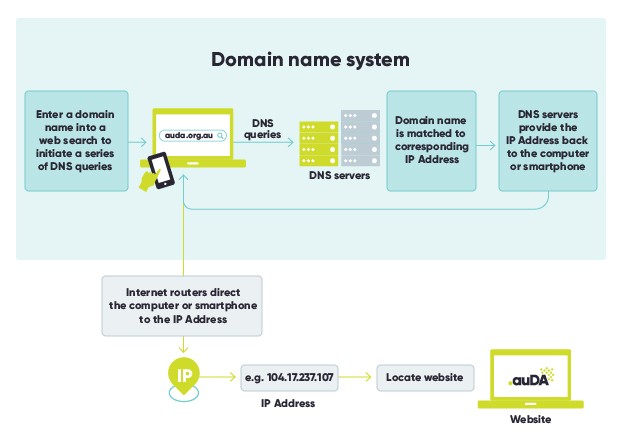Domain names and the DNS explained
Learn the basics of domain names and what happens behind the scenes to keep the internet running.

The domain name system (DNS)
The DNS is critical infrastructure that enables internet users to quickly and accurately navigate the internet. It matches domain names with the numerical Internet Protocol (IP) addresses that computers use to connect to other internet connected devices and content on the internet.
What is an IP address?
Every internet connected device, website and email server has a unique Internet Protocol (IP) address that identifies where it is hosted online. IP addresses consist of lengthy combinations of numbers and dots (e.g. 1.1.1.1) that are easily interpreted by computers but less user-friendly for internet users.
What is a domain name?
Domain names are user-friendly identifiers that are easier for people to recognise and remember (e.g. auda.org.au). They improve the ease of using the internet.
When a domain name is typed into a web browser or email address field, a DNS query is initiated, enabling the DNS to locate the corresponding IP address, and in turn, identify where the online content sought is hosted online. This improves the efficiency and ease-of-use of the internet and removes the need to memorise lengthy IP addresses.
Domain name levels
Like street addresses, which have numbers, street names, suburbs, cities and countries, domain names are structured in hierarchical levels to help identify and organise them.
Top-Level Domain
A Top-Level Domain (TLD) is the string of characters that follow the last ‘.’ in a domain name. There are two categories of TLDs:
- Country code Top-Level Domains (ccTLDs): These are specific to individual countries or territories and include “.au” for Australia, ".nz" for New Zealand and ".uk" for the United Kingdom. Each country code is specified in the International ISO 3166 standard.
- Generic Top-Level Domains (gTLDs): These are not tied to a specific country or territory and include ".com," ".org," and ".net", as well as more than a thousand other names such as .xyz.
Namespaces
Within each TLD, there can be a range of namespaces for people to register domain names.
In the .au TLD domain, there are several different namespaces serving different sectors and purposes.

These include com.au, .au direct, org.au and edu.au to name a few. Rules for who can register in each namespace, and what domain names they can register, vary between namespaces.
How the DNS works
The DNS is powered by a global network of DNS nameservers that operate in a hierarchy. When an internet user enters a domain name into a web browser, a DNS resolver reads the domain name as a query and passes it through the network of DNS nameservers until the IP address for the website or email server you’re looking for is located.
The DNS carries out the following steps to locate a website:
- You type auda.org.au into your web browser, which initiates a series of DNS queries
- A DNS resolver asks the first DNS nameserver (one of the root nameservers) for the IP address of the DNS nameserver that holds the records for the .au TLD
- The DNS resolver then asks the .au server for the IP address of the org.au DNS nameservers
- The org.au DNS nameservers locate the servers (known as authoritative nameservers) that contain the IP address for the website associated with the auda.org.au domain name
- The DNS resolver then sends the IP address back to your computer or other internet connected device
- Internet routers then use the IP address associated with auda.org.au website to route information between your computer and auda.org.au website through the internet.

While this may seem like a lengthy process, DNS queries are resolved rapidly. On average, .au DNS queries are processed within 250 milliseconds 99.99 per cent of the time. In 2023-24, the .au DNS processed an average of seven billion queries each day.
The .au domain
The .au domain is the country code top-level domain for Australia.
The .au domain is used by businesses, organisations and people with a connection to Australia, such as businesses registered to trade in Australia and Australian citizens. There are many benefits to registering a .au domain name ranging from connecting to the Australian market, to security and reliability.
Management and administration of .au domains are overseen by us, the .au Domain Administration (auDA).
With more than 4.2 million .au domain names registered, .au is among the most popular domains in the world.
auDA’s role in the .au DNS and .au domain names
auDA has an agreement with the Internet Corporation for Assigned Names and Numbers (ICANN) to manage the .au domain. Additionally, auDA is endorsed by the Commonwealth of Australia to administer the .au domain in the interests of all Australians.
Federal legislation recognises the .au DNS as Australian critical infrastructure under the Security of Critical Infrastructure Act 2018 (Cth) as it is an essential service for the Australian community. Ensuring the stable, secure and reliable operation of the DNS within the .au domain is a core function of auDA.
auDA also administers a licensing regime for .au domain names. auDA facilitates the development of the rules and policies that govern .au domain names through multi-stakeholder processes and consultation with the community. This includes developing policies for .au domain names to provide the greatest benefit for the Australian community and ensuring high levels of compliance with these policies.
